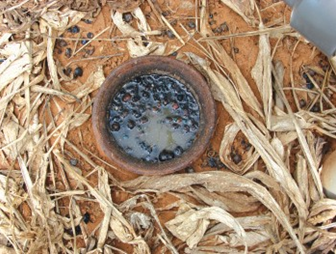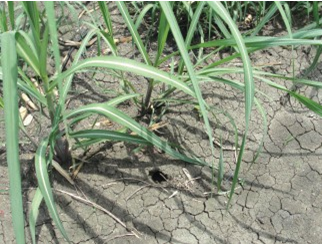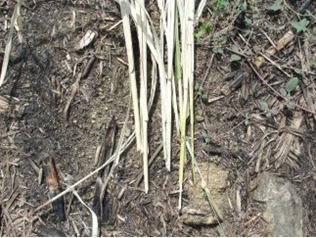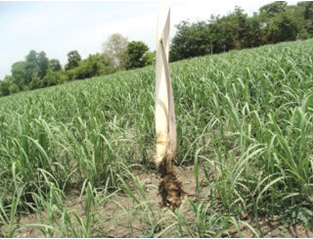Mud pot trap for white grub management
Introduction
White grub (Holotricha serrata) is an important sub-terranean pest of sugarcane in tropical India. It is a serious menace especially in hilly areas. The adults feed on foliage of host tree like neem. The best way to control white grub is when the adult comes above ground and congregate in neem trees, farmers have to collect the beetles on the very day of the receipt of summer showers and continue the collection for a week. This is the common recommendation for management of white grub in sugarcane. But, a farmer from Ganeshpuram village of Erode district has been following an indigenous practice to control white grub in sugarcane.
Description
Castor seed based mud trap was used to control white grub. One kg of crushed castor seed (Ricinus communis) is mixed with four litres of water. The extract is kept in a five litre mud pot. The pots are buried in the soil to brim level earlier to the summer showers. Five such pots are buried per acre in the four corners of the field and one in the middle of the field and it serves as a trap to attract white grub beetle.
Farmer’s perspective
The farmer reported that the odour emanating from the extract attracts white grub beetles and they were trapped into the pot. Further, the farmer observed that placing the pots in bright sunlight area enhanced the fermentation and trapping of more beetles. This practice not only controls white grub beetle, but also, attracts other insects present in the sugarcane field.
Scope and utility
The expenditure for the practice is around Rs. 325 (Five kg castor seeds cost around Rs. 125 and five pots cost around Rs. 200). The farmer says “I used this low cost technique and successfully managed white grubs in sugarcane”.
The ingredients are locally available and hence, the investment cost is less. It reduces the insecticide cost and the practice is eco-friendly.
Rationality
It is evident from the field observation that this trap is attracting different insects in the sugarcane field, but the particular Holotricha sp is a seasonal bound insect, so the extent of management of white grub by the trap has to be confirmed based on the field trails during the peak season when the adult activity is more.
Present status
This practice is mainly used to control white grub in sugarcane. By observing the effectiveness of the practice for white grub control, other farmers in the village are also adopting the practice.
 |
 |
| Mud pot trap at farmer’s field |
Plant based pest repellents for green pest management in sugarcane cultivation
Introduction
Green pest management is a pest control strategy that manages the pests with organic (plant based) materials of natural origin. It is an extension of integrated pest management. Plant–based repellents have been used for generations as a traditional practice to protect against host-seeking mosquitoes (Marta and Moore, 2011).
Plant repellents contain compounds that they use in preventing attack from phytophagous (plant eating) insects. These chemicals fall into several categories, including repellents, feeding deterrents, toxins and growth regulators (Isman, 2006). Eventhough, the scientific literatures document bio-activity of several plant derivatives, only a handful of botanicals are currently used in agriculture. Pyrethrum and neem are well established commercially available botanicals. Keeping the importance in view, an effort was made to document the plant based repellents used in sugarcane cultivation by different farmers in different places and the findings are as follows:
Tobacco based pest repellent for borer management
Description
Shri. Chinnarasu from Siruvallikupam of Villupuram district prepares an indigenous mixture for pest management in sugarcane. Half kg of tobacco powder is added with cow urine and the solution is filtered and the filtered solution is added with each half kg of ginger, garlic and green chilli paste. This mixture is kept for a day. After a day, it is applied for sugarcane @ 100 ml/10 litre of water to ward-off pests. The spray is given three times at 35, 65 and 95 DAP. The farmer says “tobacco based indigenous mixture acts as an insect repellent against Early Shoot Borer (ESB) and Internode Borer (INB) in sugarcane”.
Neem based pest repellent for early shoot borer
Description
Shri. Murugan from Marayoor of Idduki district prepares botanicals for pest management in sugarcane. Ten kg of neem (Azadirachta indica) leaf, two kg of Calotropis or Erukku (Calotropis gigantia) leaf and 3 kg of common leucas or Tumpai (Leucas aspera) leaf are mixed in 20 litres of cow urine and this mixture is diluted in 200 litres of water and allowed for fermentation in mud pots. After 45 days, it is filtered and sprayed for sugarcane to avert pest infestation at 20 and 40 DAP. The farmer reported that the practice is mainly good for early shoot borer management in sugarcane.
 |
| Neem based pest repellent sprayed field at Maryoor, Kerala |
Neem based pest repellent for wooly aphid
Description
Shri. Palanisamy from Madurai district prepares a neem based repellent for wooly aphid management in sugarcane. Neem leaves, neem cake (1kg) and neem oil (0.5 litre) are mixed in soap solution. The mixture is kept for 10 days. After 10 days, it is filtered and the liquid is sprayed for sugarcane. The farmer says “the neem based mixture is reducing the problem of wooly aphid in sugarcane.”
Datura based pest repellent for wooly aphid
Description
A farmer Shri. Venkataraja from Velayuthapalayam village of Karur district prepares botanicals for wooly aphid management in sugarcane. Equal quantity of leaves of Oomathai (Datura metal), Pungam (Pungamia pinnata), Neem (Azaridachta indica), Nochi (Vitex negunda), Chotrukatralai (Aloe vera) and Erukku (Calotropis gigantia) are mixed and ground into powder and mixed with cow urine and filtered. The filtered solution is added with water and sprayed @ l litre/tank. The farmer reported that the practice is good for managing wooly aphid in sugarcane.
Various plants used for green pest management in sugarcane cultivation
| S. No |
Plant used |
Tamil name |
Botanical name |
| 1. |
Neem |
Vempu |
Azardirachta indica |
| 2. |
Calotropis |
Erukku |
Calotropis gigantia |
| 3. |
Common leucas |
Tumbai |
Leucas aspera |
| 4. |
Nochi |
Nochi |
Vitex negunda |
| 5. |
Aloe vera |
Chotrukatralai |
Aloe vera |
| 6. |
Karanji |
Pungam |
Pungamia pinnata |
| 7. |
Datura |
Oomathai |
Datura metal |
| 8. |
Tobacco |
Pugaiyilai |
Nicotiana sp |
| 9. |
Ginger |
Inji |
Zingiber officinale |
| 10. |
Garlic |
Poondu |
Allium sativum |
| 11. |
Green chilli |
Milakai |
Capsicum annuum |
Scope and utility
F The ingredients used for preparing the plant based repellents are locally available hence, the investment cost is reduced to a greater extent. This is very simple to prepare and use and the efficiency of majority of the botanical repellents are already proven.
F Further, it does not harm the beneficial insects and the practice is environmentally safe.
Rationality
A study conducted by Singh (2011) to test the plant based insecticide against Dimorphopterus gibbus (black bug) of sugarcane reported that Neem (Azardiracta indica), Custard apple (Annona reticulate) and Karanji (Pongamia pinnata) based insecticides have emerged as safer alternatives. Usage of Neem 0.5% and 0.1% and Annona 0.1% caused
86.72, 70.28 and 64.06 % mortality of eggs of black bug, respectively.
Studies have also revealed the efficacy of plant produce against pests. Essential oils of cumin (Cuminum cyminum), anise (Pimpinella ansium), oregano (Origanum syriacum var. bevanii) and eucalyptus (Eucalyptus camaldulensis) were effective as fumigants against the cotton aphid (Aphis gossypii) and the carmine spider mite (Tetranychus cinnabarinus), two greenhouse pests (Tuni and Sahinkaya, 1998). Efficacy of basil (Ocimum spp.) against garden pests has been reviewed (Quarles, 1999).
Present status
Knowledge on traditional repellent plants obtained through ethno-botanical studies are a valuable resource for the development of new natural products. Botanical insecticides have long been touted as attractive alternatives to synthetic chemical insecticides for pest management because botanicals reputedly pose less threat to the environment or human health. Even though farmers are using the plant based repellent with their limited knowledge and awareness, still there is a lot of scope to develop target pest based plant repellent. Intensive research studies have to be taken up to develop plant repellents for each pests of sugarcane for sustainable sugarcane cultivation.
3.2.3. Low cost practices for white grub management
Background
White grub is a major menace in sugarcane cultivation. White grub larvae feed on the roots extensively and cause yellowing and drying. The late larval stages, initially feed on the roots of sugarcane and subsequently damage the underground portion of cane. White grub adults lay eggs in sugarcane field and its third instar grubs feed voraciously on sugarcane roots for three to four months. Hence, it is important to control the adult as well the larvae. White grub larvae are present nearer to the root zone of the crop, so application of insecticide is not much effective against the larvae. In this condition, a traditional practice was found useful to control white grub larvae.
Description
Mr. Srinivasan, a farmer from Lakshipuram village of Villupuram District used a simple method to control white grub larvae. Combination of deep ploughing and Pungam cake application had good control of white grub. Immediately after a summer shower, a deep ploughing is taken up and Pungam (Pongamia glabra) oil cake is applied immediately after deep ploughing.
Farmer’s perspective
The farmer reported that deep ploughing with Pungam oil cake works well to control white grub. Earlier, the farmer used to do deep ploughing alone, but after knowing the importance of Pungam oil cake with deep ploughing, he adopted it and got good results in managing white grub menace.
Scope and utility
Pungam (Pongamia glabra) oil cake is cheap and also locally available. Further, it does not harm any beneficial insects. Further, Deep ploughing is a routine practice in sugarcane cultivation. Hence, this practice dose not involve any additional monitory burden to the farmers.
Rationality
The first instar larvae of white grub are in deep root zone area, so the deep ploughing may be effective to control the larvae. Pungam is one of the popular plant based pest repellent. So combination of deep ploughing and Pungam may shown good results.
Status of the practice
As a traditional practice, deep ploughing is being carried out by majority of the farmers. But, applying Pungam immediately after deep ploughing is followed by very few farmers in the study area.
Traditional practices for rat management
Introduction
Eighteen species of rodents are pests in agriculture, horticulture, forestry, animal and human dwellings and rural and urban storage facilities in India (Prashad, 1999). Heavy losses are caused by rats in sugarcane cultivation. Field surveys in various districts clearly revealed that more than fifty per cent of the sugarcane cultivating districts in Tamil Nadu are facing rat problem. Sugar factories and farmers are taking up several measures to control rats, but still it is a big challenge for them. During the survey a farmer reported that he is ready to spend Rs. 6000 per acre to control the rats, but he is not able to do it and he tried several ways but, still he faces severe problem of rats in his field. It shows the magnitude of rat menace in sugarcane cultivation.
The review shows that five predominant species are causing severe damage for sugarcane cultivation in India. In the early stages of the crop, the rat damage is not a serious issue and control efforts are probably not yet warranted. However, rat damage starts from 4th month and continue up to harvest. The use of rodenticides is the most common method to control rodents in agriculture. However, in due course of time rats developed resistance to rodenticides and continuous usage of rodenticides is raising the
question of soil and environmental issue. Therefore, the need of the hour is integrated approach to curtail rat menace. Farmers are adopting different indigenous ways to manage the rat problem. These practices are to be taken care while formulating the integrated approach for rat management.
Description
Shri. Ramchandran from Keel Koodalur of Villupuram district cultivates sugarcane for more than 15 years, but, in recent time due to severe rat problem in the area, he is slowly shifting to other crops. He tried several mechanical as well as chemical methods to control rats, but all went ruin. Based on his past experience and the information from his elders and counterparts in the village, he applies Asafoetida (Ferula assafoetida) to control rats and obtained good results. Half kg of asafoetida was mixed with water and applied in ridges as well as in live holes of the rats for an acre.
Farmer’s perspective
He reported that Asafoetida is to be applied after three months of planting when the rat menace starts. Further he says “due to the smell, rats run away from the surroundings and in last season as well as in the current season, I am not at all noticing the rat problem in the field”.
Scope and utility
“The cost (Rs. 400/acre) incurred for Asafoetida may be little higher, but the outcome of the practice is huge” the farmer reported.
The pungent odour may be the reason to ward of the rodants from the field.
Rationality of the practice
Mr. N. Madu Balan, Assistant Director of Agriculture, Dharmapuri recommends the use of Asafoetida to prevent rat damage in drip lines. Asofoedita can be wrapped in a muslin cloth and tied to the irrigation tank in such a way it is dipping inside the water or placed on the irrigation channel. It gets slowly dissolved in the running water and acts as a rodent repellent also (https://www.facebook.com/groups/madhualan and Farm query, The Hindu).
Present status
As a traditional practice, it is followed by the farmers who are aware about the practice. It may be out-scaled as a part of integrated rat management strategy.
 |
 |
| Live holes in the field |
Symptom of Rat damage |
 |
 |
| Rat damaged fields at Keel Koodalur village |
|

